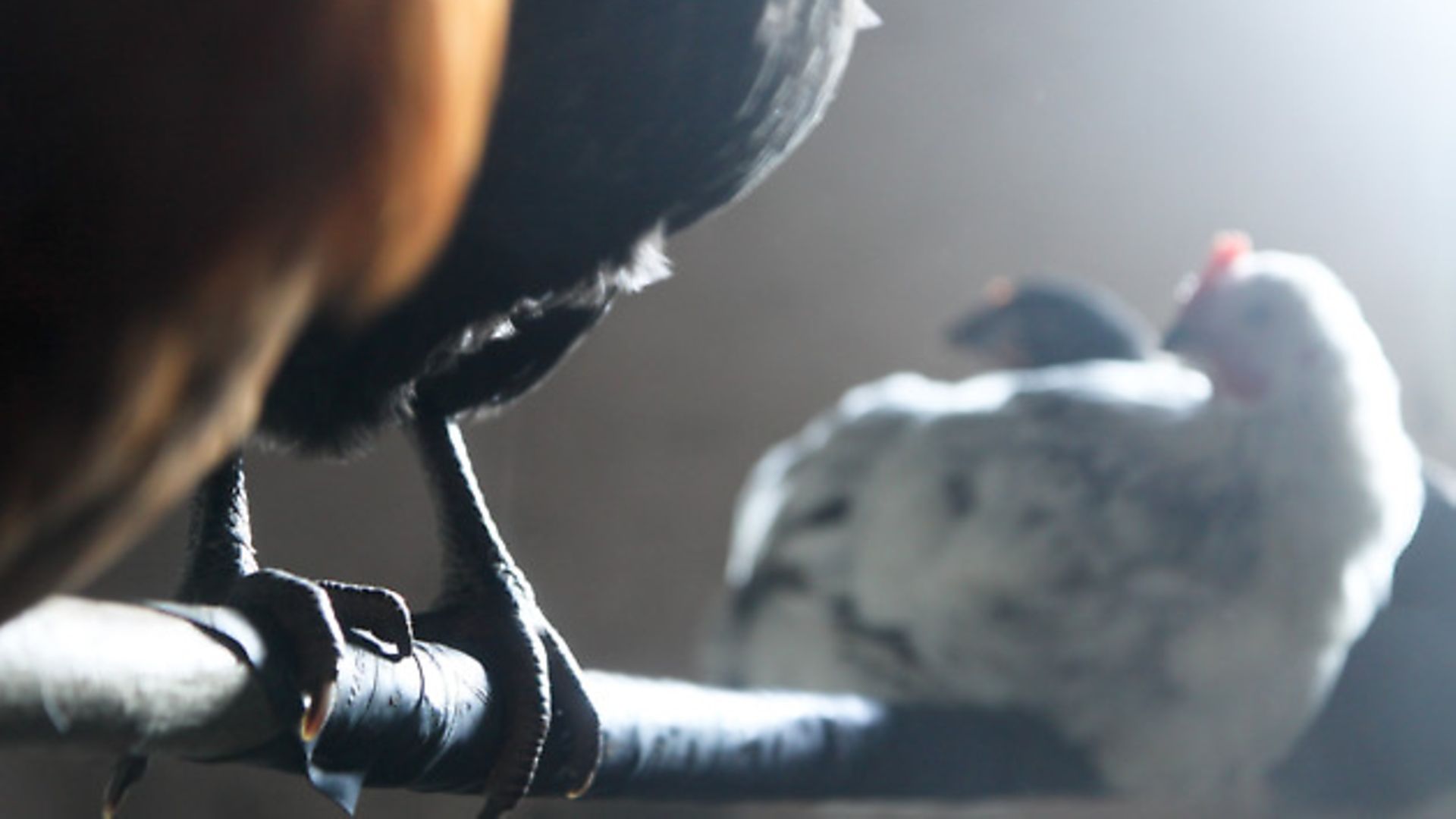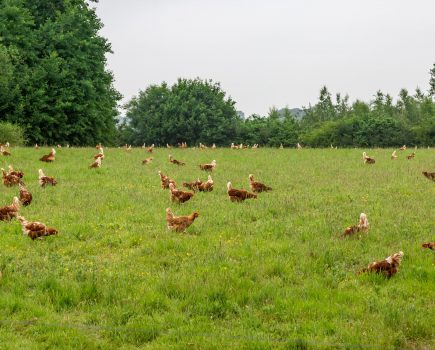Julie Moore discovers that a non-rounded stable and softer perch is more desirable for the welfare of modern day hens

Chickens like to perch; it’s all part of their natural behavioural repertoire and is exactly what Gallus gallus did some 5,000 years ago in the jungle. Even today, our domestic hens are similar to their wild ancestors in terms of their motivation to find a safe perch for the night, away from floor predators. But perching can cause unnecessary welfare problems if inadequate perches are provided.
When hens perch, they tend to sit mainly on their keel bone rather than putting weight through their foot pads. This causes a higher pressure load on the keel bone than the foot pads when perching which may or may not be evenly distributed depending on the perch. If pressure points are concentrated, problems with both keel bones and foot pads could arise which are detrimental to the health of your flock and can also impact egg productivity. The perfect perch, tailored to your birds, should encourage a restful night so the girls are fully energized for the day ahead.
Scientific research has shown that hens with keel bone fractures lay fewer eggs than hens with no fractures — a possible explanation is that calcium is being used in bone healing rather than egg formation. The mobility of hens with keel bone fractures was also impaired, particularly with regards to flying to and from perches (the flight muscles are attached to the keel bone) and they spent more time in the nest boxes than their fracture-free counterparts.
Foot pad lesions such as bumblefoot can be caused by a number of different factors, but perch choice can play a part in the development of the condition. If a perch is: too narrow, pressure is focused in one small area of the pad; too smooth, the foot is always slipping, causing friction between the pad and perch; or set too high from the ground, a lot of pressure is put on the foot pad every time a bird flies down from the perch. Foot pad lesions can cause limping and lameness in your flock.
In the wild, Gallus gallus has a wide choice of roosting branches which differ in shape, structure and width leading to varying pressure distribution between foot pads and keel bones. In a domestic situation, a hen is limited in choice of perch, being reliant upon the chicken keeper providing a suitable roost which may not allow for pressure distributions. Domestic hens, unless they are free-ranging, spend more time perching in the daytime than their wild counterparts causing an extended period of pressure load. In addition, modern hybrids are generally heavier than their female jungle fowl counterparts, thus resulting in a higher pressure on keel bones and foot pads when resting.
So what exactly is the ideal perch design that is beneficial to the welfare of your hens? According to a recent scientific study undertaken at the Institute of Animal Welfare and Animal Husbandry at the University of Muenster, Germany, the obvious and common choice of perch found in the backyard or woodlands is not necessarily the best choice for your birds.
The study set out to examine laying hens’ perching requirements and thus identify an adequate perch design that will increase animal welfare. The study investigated the behaviour of laying hens on perches and analysed the effect of different perch materials and diameters as well as perch temperatures. The pressure load on the foot pads and keel bones of the hens on different perches was also recorded.
In the first study, hens were randomly offered one of nine round perches of differing materials (wood, steel or rubber cover) and diameter (27, 34 or 45mm). The duration of sitting, standing, preening and frequencies of balance movements by the hens were recorded at night.
The results showed that as perch diameter increased, balance movements decreased — movements were less frequent on rubber perches as opposed to wood and steel perches. So a larger rubber surfaced perch improved not only the footing stability of hens but also the quality of their sleep. But a perch that is too wide for the size of the hens’ feet may cause tendon problems and impair a hen’s ability to grasp the perch. Further results found that the various perch materials encouraged differences in the resting posture of the hens. The study concluded that the resting posture a hen adopted was likely to be related to the thermal properties of the perch material rather than perch design.
Study two set out to examine the effect of different perch surface temperatures (15C, 18C and 28C) on the resting behaviour of laying hens. The results showed that the time spent perching was unaffected by perch temperature. Hens were, however, sensitive to different surface temperatures; high perch temperatures disturbed resting, causing more active behaviour whilst low temperatures encouraged more restful behavioural patterns that prevent heat loss i.e. hens either ‘hunched down’, fluffing up their feathers to trap heat or tucked their heads under their wings to reduce surface area heat loss
The third study determined whether or not pressure load played a key role in the development of foot pad lesions and keel bone deformations. Firstly, solid test perches of round, oval and square shapes with three different diameters were investigated. Secondly, commercially used perches (round steel tube, two sizes of plastic mushroom-shaped perches and a flattened round plastic perch) together with two prototypes (soft, round polyurethane perches with an air cushion) were tested.
Of the solid perches, the square perches minimised pressure on the keel bone the most whilst oval perches were more suited to hens’ foot pads. Amongst the commercially used perches, no difference in keel bone and foot pads were found in sitting hens, but when hens stood, the steel perches were the least favourable for hens’ foot pads. The prototype perches reduced both the keel bone and foot pad pressure peaks whilst the 48mm width prototype provided the largest keel bone and foot pad contact areas.
The study found that in general, the pressure peak on the keel bone of a sitting hen is five times higher compared with foot pad pressure peaks. The ultimate perch should therefore be shaped to provide maximum contact area for the keel bone i.e. square with rounded edges. The soft perch materials in the study implied not only a better grip and foot stability during perching but also improved pressure conditions on foot pads and keel bones, all of which enhance sleep quality.
So how can you help your girls to sleep more comfortably?
The first step is to decide on the width of your perches. This will be dictated by the total foot length, measured from the tip of the hind toe to the tip of the middle toe, of your hens. As hens should be able to encompass a perch with their toes without contact between their middle and hind toes, the minimum perch perimeter should be at least the total foot length. If you keep different breeds, it’s unlikely that ‘one size fits all.’ In such cases it will be beneficial to provide an appropriate assortment of perch widths, so that your hens can choose. As hens will naturally perch on the highest roost available, ensure that all perches, irrespective of width, are at the same height so that there is no fighting amongst the chickens for the highest roosting spot, which may or may not be the ideal perch for their needs.
The Poultry Club of Great Britain Welfare Guidelines recommend that ‘perches should be a minimum of 4cm wide, not round, to avoid twisted keel / breast bones’. This supports the scientific research that square perches with rounded edges are best for the welfare of your hens.
Once you’ve calculated the best perch width(s), you’ll need to make it softer whilst providing more grip for your hens.
If you have a budding cyclist in your family, chances are they’ll be throwing out worn inner tubes. An inner tube cut lengthways can be wrapped spirally around your solid wooden perch and stapled or taped into place on the underside. Alternatively, you can use a solid rubber insulating tape (a 10m roll, 50mm wide and 3mm thick will cost around £7 from DIY stores) in the same way, wrapping spirally around the perch. As a hygienic perch surface is another important feature of a suitable perch, both of these wrappings are easy to clean should any manure accumulate. The wrappings may also deter red mites who like to live in cracks on the underside of wooden perches. The taping can also be easily unwound and replaced as necessary. Avoid using foam pipe lagging — it looks luxurious, but your chickens may eat it if they are bored!
The modern domestic hen has evolved over the millennia and with that development come different needs from her wild ancestors. Whilst Mother Nature’s provision for roosting was perfect for Gallus gallus, a non-rounded stable and softer perch is more desirable for the welfare of modern day hens. Are your chickens sitting comfortably and getting the good night’s sleep they deserve?
Image(s) provided by:
Archant







